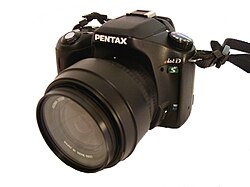 Front view of the Pentax *ist DS (zoomed), a digital SLR camera. | |
| Overview | |
|---|---|
| Maker | Pentax |
| Type | DSLR |
| Lens | |
| Lens mount | Pentax KAF bayonet mount |
| Sensor/medium | |
| Sensor type | CCD |
| Sensor size | 6.1 megapixel |
| Maximum resolution | 3008 x 2008 |
| Recording medium | SD/MMC card |
| Focusing | |
| Focus | autofocus, manual |
| Flash | |
| Flash | built-in, hot shoe |
| Shutter | |
| Frame rate | 2.8 fps for 8 frames |
| Shutter speeds | 30 s - 1/4000 s |
| Viewfinder | |
| Viewfinder | pentaprism, 95%, 0.95x |
| General | |
| LCD screen | 2.0 " TFT LCD, 210,000 pixels |
| Battery | 4 AA |
| Data port | USB |
| Dimensions | 129×95×60 mm (5.1×3.7×2.4 in) |
| Weight | 605 g (21 oz) w/ battery |
PENTAX *ist DS is a digital SLR camera produced by Pentax. The *ist DS produces a 6.1 megapixel resolution image. The *ist DS was a lower-prices follow-on to the Pentax *ist D. In September 2005 the Digital Imaging Websites Association (DIWA), a worldwide organization of collaborating websites, announced that Pentax had received their first DIWA Award for a DSLR camera. The *ist DS model was awarded with a Silver medal for outstanding test results.
